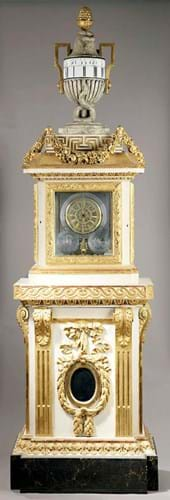
Monumental astronomical clock dating from c.1770 attributed on stylistic grounds to the royal clockmaker Louis Bouchet, estimate €600,000-800,000 at De Baecque & Associés.
Image copyright: De Baecque & Associés/Drouot
The clock, which dates from c.1770, has a wealth of technically innovative features.
The three dials on the front show mean and solar time, the zodiacal calendar, the date, days of the week and phases of the moon as well as the names of 49 cities or islands, some of which were used as observation stations for the passage of Venus in front of the sun in 1761 and 1769.
Complex movement
It has a skeletonised movement visible through a glass aperture that is mirror backed to show the complexity of the movement and is, says Anthony Turner, sale expert for the piece, “an exceptional example of the first generation of skeleton clocks”.
Though unsigned the clock is attributed on stylistic grounds to the royal clockmaker Jean Louis Bouchet.
It is set in an elaborate wooden case stamped by Jean Baptiste Guillaume Prévost. This is designed in the newly fashionable neoclassical style with a sculpted wooden faux marble urn that contains the revolving dials indicating the hours and minutes in mean time.
The clock was made for Michel II Velut de La Crosnière, a collector who was passionate about watchmaking, practising the discipline as an amateur as well as having a collection of mechanical devices and a cabinet of natural history.
When it comes up for auction at Drouot in June it will have an estimate of €600,000-800,000.














